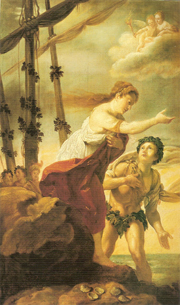13 November 2014
 In the age of The Voice and X-Factor, classical music concerts are fast becoming the preserve of elite, ageing audiences with declining numbers of younger people in attendance.
In the age of The Voice and X-Factor, classical music concerts are fast becoming the preserve of elite, ageing audiences with declining numbers of younger people in attendance.
How to boost that attendance is motivating the research of performer and University of South Australia scholar Dr Daniela Kaleva, who, this month, will present two contrasting performances of Monteverdi’s Lamento d’Arianna, at the Mortlock chamber, and those attending will be asked to indicate which version they prefer and why.
The first performance will be a concert version of the lament, presented in a modern context, while the second performance will be presented with a 17th Century twist – in full theatrical costume delivered in early recitative style, complete with rhetorical gesture and breaking the fourth theatrical wall.
Mezzo-soprano and music lecturer, Dr Kaleva, who will be performing as Arianna herself, explains what the two different versions can reveal about audience engagement.
“The first performance will be a modern concert version, a solo chamber piece and it is one which many famous names have sung because the lament has such a powerful emotional charge,” Dr Kaleva says.
“New research into the way the lament was historically performed informs how the second performance will be presented. It will be in representative style that blends rhetorical gesture and comedia dell’arte. Putting the lament in its original dramatic narrative is the idea with those techniques and practices.
“This includes Arianna’s lady-in-waiting Dorilla and modern sound design incorporating the chorus of fishermen which intersperses the lament and the voice of Bacchus at the end of the opera.
“Learning how we can present the lament in a way that is clear and compelling, and attractive to audiences is what we are trying to achieve.
“By inviting our audience to register their responses to each performance, on tablets, on the night, and then by completing a longer survey later, we can learn about their emotional responses and increase our understanding of what really engages them in the performance and keeps their attention.”
That understanding could help address classical music attendance figure decline. Dr Kaleva says data collected by the National Endowment for the Arts indicates that between 1982 and 2008 fewer people participated in the arts in United States, with a steep decline noted in those attending classical music events.
“This is why it is important that we understand our Australian audience, what appeals to them and how that information can be used to attract others,” Dr Kaleva says.
Dr Kaleva’s research will also try to determine how the representative style works in rehearsal and performance, breaking new ground in baroque performing practice. The comparative audience reception study will inform her role as an Associate Investigator for The Australian Research Council Centre of Excellence for the History of Emotions.
Event registration to attend both performances, which will take place in the evening of November 25, is available through this web link: http://ow.ly/E9adn
Contact for interview: Daniela Kaleva office (0)8 8302 4521 email Daniela.Kaleva@unisa.edu.au
Media contact: Will Venn office (08) 8302 0096 email will.venn@unisa.edu.au




